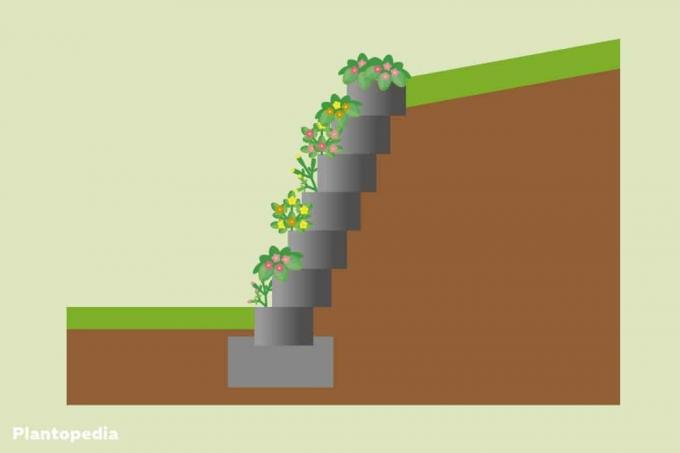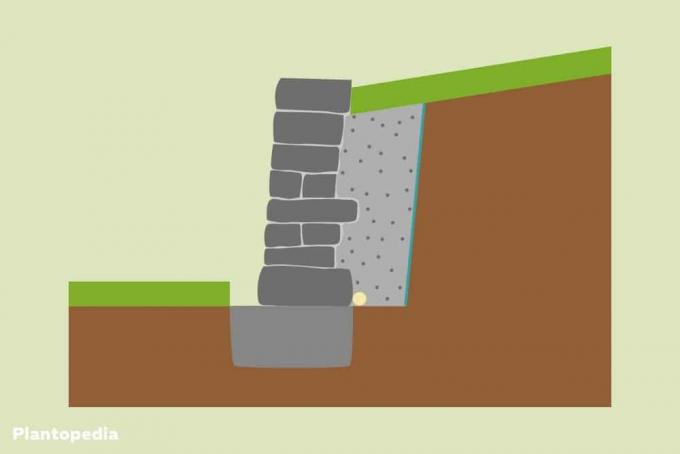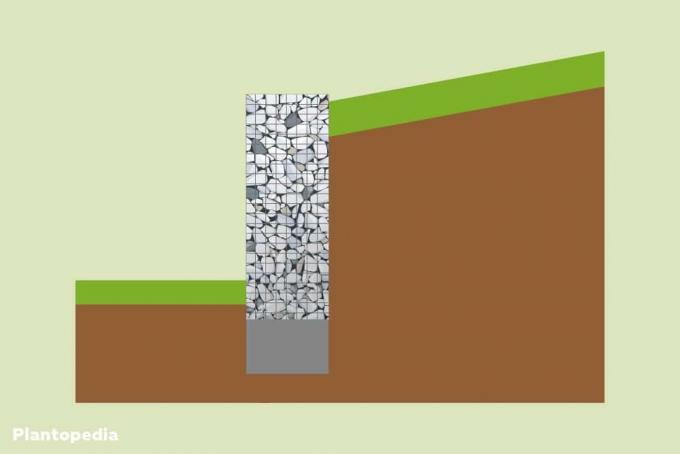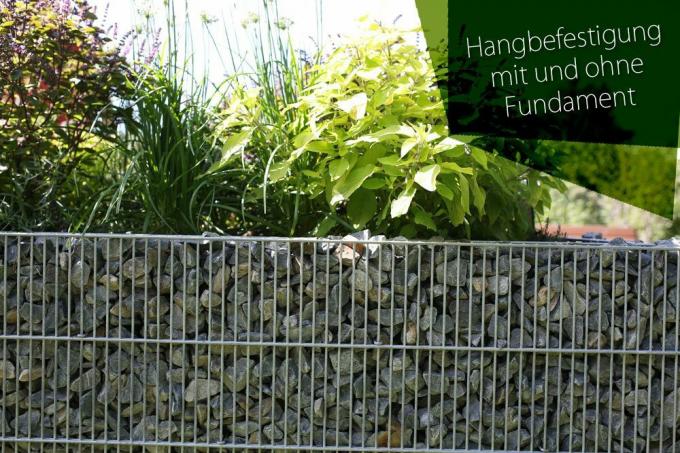
table of contents
- Slope reinforcement with foundation
- L-stones
- Plant stones
- Dry stone wall
- Gabions
- Slope reinforcement without a foundation
- planting
- Fascines
If your own property is not straight, you can use a slope reinforcement for steep places that can be easily removed. If you want to fix your slope, there are several variants available that work with and without a foundation. On the one hand, they serve as protection against erosion and a decorative aspect, for example if you want to design several slopes as terraces. We will introduce you to the various methods for this project in detail in this article.
Slope reinforcement with foundation
Foundations of various types are used for classic slope fastenings, which form the basis for the fastening. The foundation allows even heavy materials to be used as a fastening without them sinking into the ground or shifting due to the weight of the earth. Since these materials do not fix themselves, they are dependent on foundations and then act effectively to secure the slope. If you have decided on an attachment with foundations, four variants are available to you, which are illustrated in detail in the following sections. When choosing a suitable method, the slope of the affected area is particularly important, as not every one is suitable for particularly steep slopes.
L-stones
One of the classics for fastening slopes is the use of L-stones. Due to the L-shape, they are ideal for this application, as they fix the soil and fit together seamlessly. L-stones have the great advantage that they are quite heavy, which is important if you want to pave a slope. Due to the weight of the stones in combination with a suitable foundation, the slope is permanently and effectively protected against erosion, even in heavy rainfalls and thaws. A foundation is poured for the L-stones, which corresponds to the length of the slope and the width of the stones. The stones can be attached to this. L-stones are particularly suitable for the following slopes and projects:
- Steep slopes
- Terraces
- slopes endangered by erosion
Although you have to purchase taller and wider stones for steep slopes, they are bomb-proof with a suitable foundation and can support the soil even in heavy rainfalls. Except for the delivery and transport of the L-stones, the project can be implemented without any major problems. Just make sure that you should place stones in terraces from a height of three meters in order to avoid excessive stress from the soil.

Note: Due to the weight of the L-stones, you can also lay a thick foundation of gravel or crushed stone for them. The stones hold up quite well on this if the slope is not too steep.
Plant stones
Another method are plant stones, which are mainly used in gardens, which otherwise not so much Have space or provide additional space for the cultivation of a wide variety of plants should. Select the plant stones according to your garden in order to achieve a harmonious effect. Size, color and shape can be chosen by you. Since a gravel and concrete foundation is required for a slope fastening on plant stones, even uneven slopes can be fastened without any problems. The trench for the foundation simply runs along the embankment. You should pay attention to the following points with this slope reinforcement:
- Concrete foundation: about 30 cm
- Gravel foundation: 60 to 100 cm
- maximum angle of inclination: 70 °
- Intermediate gravel layer: 30 cm
The stones are moved backwards according to the inclination. About half of a plant stone should be covered with another plant stone in order to provide the desired hold. Proceed in this way until the entire slope reinforcement is in place. Then you can plant the individual stones. The maintenance effort is particularly high with this attachment and must not be neglected.
Dry stone wall
In addition to the slope reinforcement with plant stones, the use of a dry stone wall is one of the most time-consuming and labor-intensive options that you can choose. For this, however, this can be adapted exactly to your own ideas and to the shape of the embankment that is being paved. A foundation made of concrete is not used for a dry stone wall, but made of gravel or crushed stone, as no wet building materials are used for this project. A combination of different stone layers is applied after the foundation with a depth of up to 80 centimeters, which fix the soil and thus the slope (from bottom to top):
- at least 10 cm of stone layer in the ground
- Tie
- Stone layer
- Tie
- set stone wedges in between
- Stone layer
This is done until the entire wall is in place. The run-up is ten to 15 percent, which you absolutely have to pay attention to. A drainage and a separating layer made of gravel, earth or sand are laid behind the stones, which are separated from the slope with garden fleece. As a result, not all of the moisture in the soil gets into the wall and it is not populated by roots and animals. The higher the slope, the smoother the slope has to be in order to provide sufficient support. The work is worth it, however, as dry stone walls look romantic and natural in the garden. Even heights of up to five meters can easily be secured with a dry stone wall. Just make sure that the stones always fit exactly.
Gabions
A modern method of paving a slope is to use sturdy gabion fences that are filled with heavy stones. Gabions come in a variety of heights and widths, and for this reason can be used for a variety of slopes. Due to the point foundation, they can be positioned precisely. Compared to the variants mentioned above, the foundation is associated with the least amount of effort, so you should rely on professional help for delivery and filling. Especially with gabions with a lot of volume, it is very exhausting to place and fill them yourself. Gabions are particularly suitable for the following projects:
- Steep slopes
- Stairs
- Terraces
- Delimitations
In addition to the high stability, the filled wire cages have an extremely decorative aspect, which brings your slope fastening to the fore. You can choose the stones and the color of the gabions and place them according to your ideas. Modern gardens can be appropriately equipped with these. Since the fences can be loaded immediately after placement, you don't have to wait for the soil to compact before you can step on and plant. The slope can be used immediately after the mesh baskets have been set and filled.
Slope reinforcement without a foundation
If you do not want to lay foundations or spend the costs for their implementation, you should rely on a slope reinforcement that can do without one. There are two classic methods you can use to secure a steep slope without digging holes and pouring concrete. Depending on the length and slope of the embankment or slope, these are quite inexpensive and in most cases do not require any equipment such as mini excavators. However, with these it is a little more difficult to create a clear line, as is desired, for example, with terraces lying on top of each other. While the foundation fixings appear modern and orderly, the following variants are recommended for a natural touch. Especially slopes in natural gardens or in the country are often paved with these methods.
planting
Plant lovers rely on one instead of foundations Attachment from a wide variety of shrubs and treesthat stabilize slopes permanently due to their growth. The roots of these plants improve the soil structure over a period of several years and provide support, especially in the upper soil layers. These are most at risk from erosion and the plants counteract this problem. The following plants are particularly suitable for this:
- Lady's mantle (bot. Alchemilla mollis)
- Cranesbill (bot. Geranium)
- Golden nettle (bot. Lamium galeobdolon)
- Waldsteinie (bot. Waldsteinia ternata)
- Elven flower (bot. Epimedium)
- Carpet St. John's wort (bot. Hypericum calycinum)
- Ysander (bot. Pachysandra)
- Ivy (bot. Hedera helix)
- Buddleia (bot. Buddleja davidii)
- liguster (bot. Ligustrum)
- Cornelian cherry (bot. Cornus mas)
- Finger bush (bot. Potentilla fruticosa)
- Ornamental quince (bot. Chaenomeles)
- Dwarf medlars (bot. Cotoneaster)
- Creeping juniper 'Repanda' (bot. Juniperus communis 'Repanda')
- Small shrub or ground cover roses (bot. Pink)
- Dog roses (bot. Rosa canina)
- Broom (bot. Cytisus scoparius)
The best thing about this selection is the combination options. No matter how steep or long the slope to be planted is, with these plants you can let your imagination run wild. Just make sure not to step on embankments after planting for the next few years or only during maintenance so that the plants can establish themselves and stabilize the soil. If you want to support insects, birds and wild animals by planting them with food and sanctuaries, focus mainly on plants like the dog rose, as it has a dense growth, as well as rose hips and nutritious flowers trains. The possible combinations are limitless.
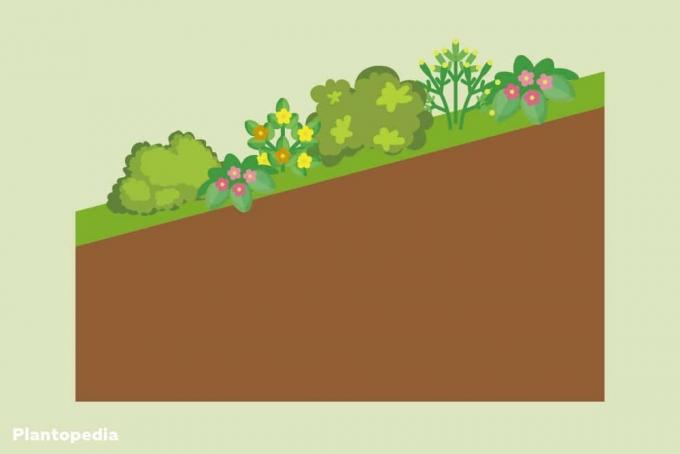
Note: If you want to secure a low embankment so that it can be walked on, the use of race on, ideally Turf from robust grasses. Even the grass roots are sufficient in this case to secure the slope and make it possible to sunbathe on it or use it for other purposes.
Fascines
A traditional method of securing slopes is to use rods from native willow species. These can be used in different ways and are suitable for other slopes and embankment lengths. Fascines that have been used for securing for centuries are particularly well suited. Bundles of rods, which together reach a diameter of about 30 centimeters, are used as slope fastening. They are around two to three meters long and can easily be laid end to end to secure even longer slopes. You can choose between the following types:
- Deadwood: no longer sprouts
- living rods: capable of germinating and sprouting
If you do not want to support additional growth of the rods, it is best to rely on dead wood. Usually these are cheaper to buy in stores or at tree nurseries. Now work out how long and high the slope is. You can stack fascines to get the height you need. You will also need wooden posts at the height of the slope for every meter to stabilize the bundles. The use is just enough:
- Dig a trench
- Depth: 15-30 cm
- Lay out fascines in bundles
- fix with posts
- use wire for a better hold
- Fill the pit
If you wish, you can still cover the fascines with wood so that they look like a closed fence. So that the bundles can secure the slope for a longer period of time, you should firmly trample the earth behind it. If your embankment has a constant slope, it can help to remove some earth at the bottom. This makes it easier to place the bundles.
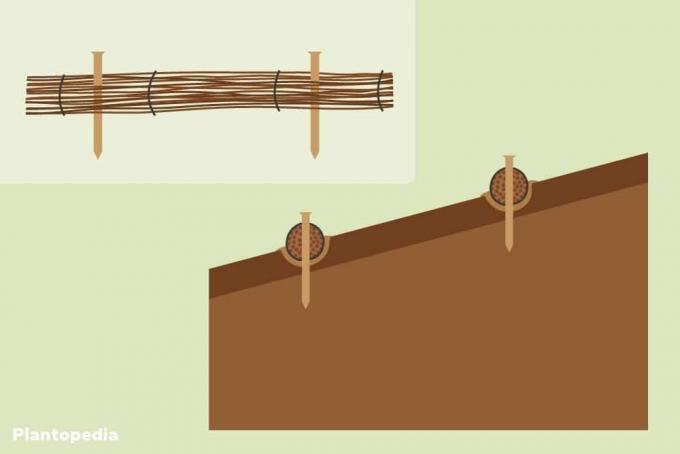
tip: You can combine the concept of planting and willow branches with each other perfectly, in order to secure even steeper slopes without having to rely on a foundation. To do this, simply plant the plants directly behind the fascines, which significantly improves stability.

